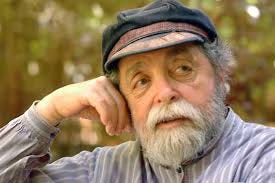Bert Salzman was my friend, teacher, and quintessential holy rascal. Last Friday was his eighth yahrzeit (death anniversary). I loved Bert and thought I’d introduce you to him.
If you look up Bert on Wikipedia, you will learn that he was born in 1931, raised in an orphanage, never graduated from high school, joined the US Marine Corps, fought in the Korean War, and won the Academy Award for Best Live-Action Short Film for directing Angel and Big Joe (1975). You won’t learn he quit commercial filmmaking after winning that award (“Who needs more than one Academy Award,” he said to me.), he was a close friend of Jiddu Krishnamurti, and he made documentary films of Ramana Maharshi and Nisargadatta Maharaj, two of the greatest spiritual geniuses of modern times.
I met Bert a quarter century ago when he and his friend Prasanna, an Indian disciple of Ramana and Nisargadatta Maharaj, came to hear me speak in Sonoma, CA. They were not easy to miss, as they were the only people who showed up. The tiny audience didn't dissuade me since I speak primarily to hear myself talk. Still, I immediately became their audience when I learned who they were.
Since then, both men have become my teachers, and Bert would call me periodically on the phone. Our conversations were short. Here is the longest one:
“Rami?” Bert said, sounding like Larry David impersonating Senator Bernie Sanders.
“Hi, Bert,” I said, feeling like Ernie from Sesame Street.
“Are you sitting down?”
“Yes, Bert.”
“Can you see your feet?”
“Yes.”
“Can you see your knees?”
“Yes.”
“Can you see your stomach?”
“Yes.”
“Can you see your chest?”
“Yes.”
“Can you see your head?”
“No.”
“Aha!” Then he hung up.
This was Bert’s version of the Zen koan, “Show me your face before your parents were born.” The idea is that you are not who you think you are. You are the infinite, eternal happening happening as all happening.
This face is the unseen seer: as soon as you look for it, it disappears in the act of looking. This is what Zen people call searching for an ox while riding on the ox. I call it looking for my glasses when they are already resting on my nose. Ramana Maharshi might call it Self-Inquiry: tracing the egoic “I” back to the timeless “I AM.” When you think you’ve got it, you ask, “Who is doing the tracing?” and the inquiry starts over again. In my experience, self-inquiry is self-erasing: you don’t go anywhere; you cease to exist everywhere. But only for a moment.
This brings me to Bert’s favorite holy rascal intervention: “And furthermore…”
“Rami?” Bert would ask over the phone.
“Hi, Bert.”
“And furthermore…” Then he’d hang up.
He often did this in person, especially if he saw me talking with someone else. He’d interrupt, say, “And furthermore,” and walk away.
Once, sitting together in his backyard by his coy pond, I asked him about this: “The idea is that whatever you are saying is at least once removed from reality. That’s because words are once removed from reality. The ‘and furthermore’ reminds you of that and brings you back to reality.” He fell silent. We made eye contact and smiled.
“Wait for it,” I said to myself.
“And furthermore,” Bert said.
The heart of Bert’s message is encapsulated in his mantrum: “No gap.”
“There is no this and that or this or that,” Burt told me. “There is only thisthat: no conjunction, no hyphen, no backslash. There is only One Thing that we divide into many things in our minds. We invent gaps where there is No Gap. Do you understand?”
“Sure.”
“Then who are you looking at when you are looking at me, and who is the you doing the looking?”
I hesitated; Bert went on.
“You are a stopgap. I am a stopgap. Do you know what a stopgap is?”
This time, he didn’t wait for me to respond.
“Stopgap is a noun. You know there are no nouns in the universe. You always say this: no nouns, only verbs; no beings, only happenings. So, as a noun, a stopgap is a fiction. A stopgap is a temporary solution to a problem—a temporary filling of a gap, except there are no gaps. Hence, a stopgap solves a fictional problem, a problem of our own invention. When you look at me, it is Nothing looking at Nothing, and…”
“But, Bert, nothing is a noun!” I shouted.
He paused, smiled, allowing me my little victory, and said, “And furthermore…”
––––––––––
Bert’s film about Ramana is Abide As The Self: The Essential Teachings of Ramana Maharshi https://www.amazon.com/Abide-As-Self-Essential-Teachings/dp/B000JCDRY0
His film about Nisargadatta Maharaj is Awaken to the Eternal
https://www.amazon.com/Awaken-Eternal-None/dp/B000JCDTXO
Please let us know in the chat if you find free ways to watch these films.



Hi Roger,
Prasanna is a powerful teacher. I used to visit him at least once a year. Sometimes to study Vashistha's Yoga, sometimes to stare into (beyond?) his paintings, sometimes to chat, and always to go out for Mexican food. I never met his sister.
Hi Rami,
What great memories of Prasanna! I might venture to guess that you two dined at La Casa, across the street from the mission.
Also, I just corrected my earlier post, as I recalled that Kusuma was involved with Shri Dhyanyogi Madhusudandas, not Nisargadatta Maharaj.